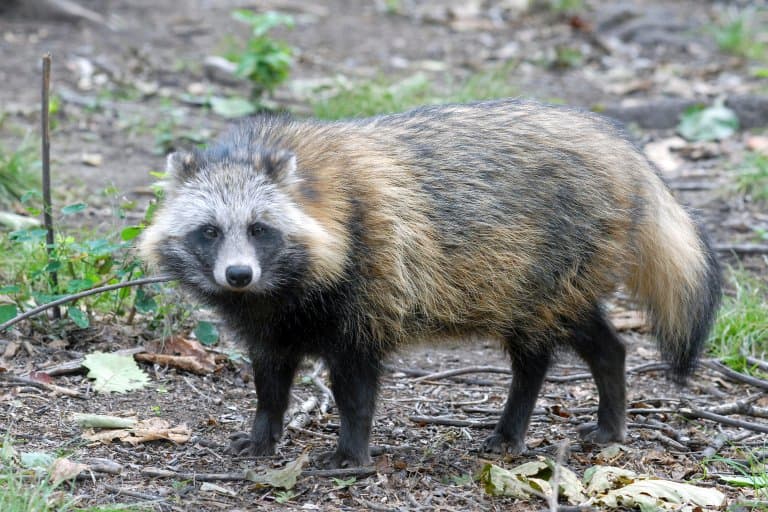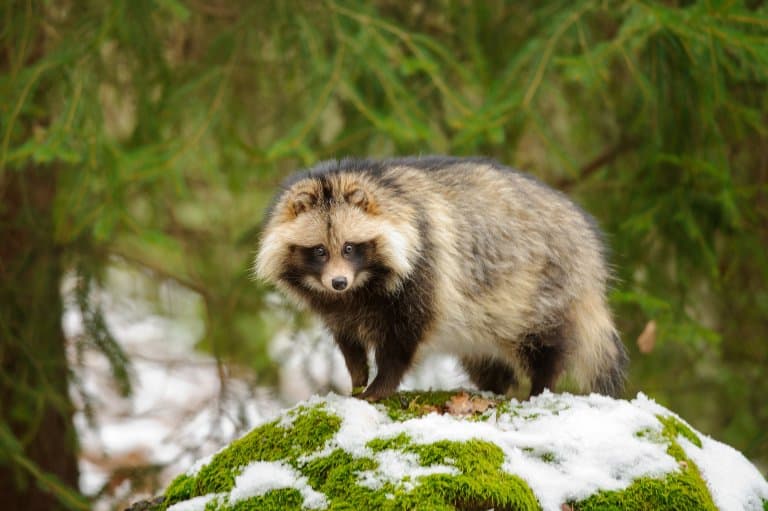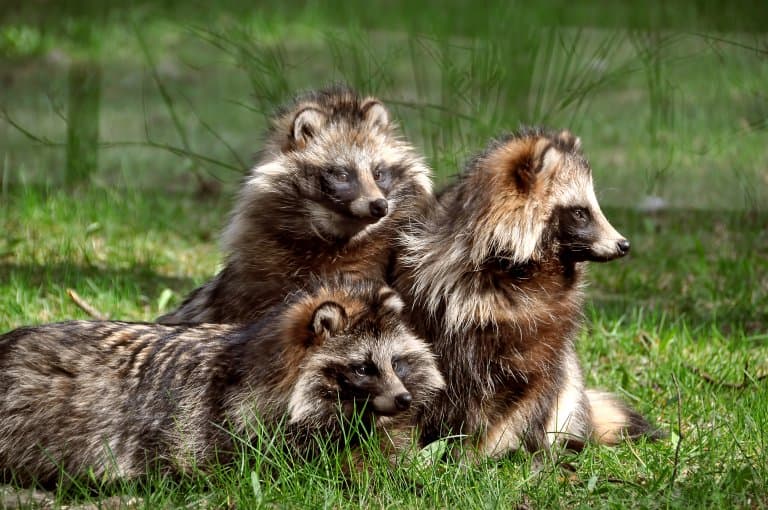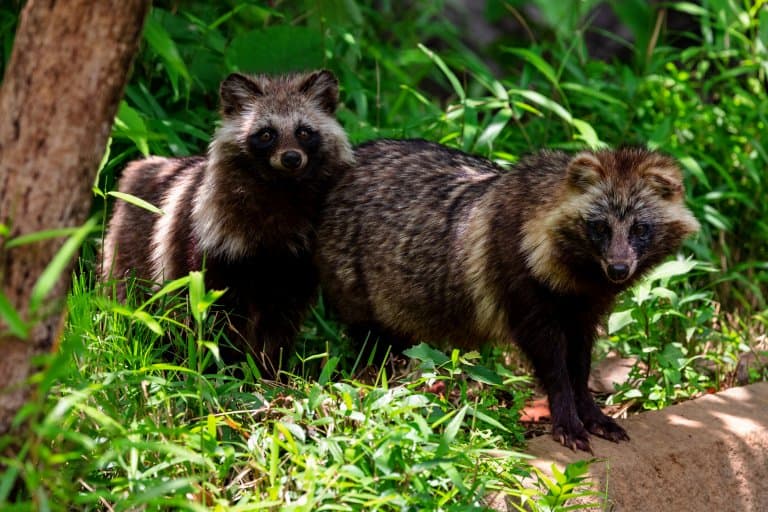Raccoon Dog Profile
The raccoon dog is a small fox-like canid native to East Asia, that has similar face markings to a raccoon on its fur.
Despite their raccoon appearance, they are more closely related to foxes.
They are widespread in their native range across Asia, and are considered invasive in Europe where they have been introduced due to the fur trade.

Raccoon Dog Facts Overview
| Habitat: | Preferably shorelines, wet, deciduous forests |
| Location: | Native to the Far East and Russia, introduced to Europe |
| Lifespan: | 7 years in captivity |
| Size: | Around 45 – 71 cm (18 – 28 inches) |
| Weight: | 3 – 10 kg (6 – 22 lb) |
| Color: | Gray/brown with black bands |
| Diet: | Omnivorous and oportunistic |
| Predators: | Wolverines, wolves, raptors, humans |
| Top Speed: | 40 kph (25 mph) |
| No. of Species: |
2 |
| Conservation Status: |
Least Concern |
Raccoon dogs are plump little canids from Asia, whose flexibility and lack of fussiness have led them to succeed in numerous other locations across the world as an introduced species. They’re invasive in some places, but not so much in others, and they may be a significant disease vector.
There are two species of raccoon dog, the common raccoon dog and the Japanese raccoon dog, known as ‘Tanuki’ in Japan. While once considered a subspecies rather than separate species, the Japanese raccoon dog differs by a smaller stomach, shorter fur and smaller skull than mainland common raccoon dogs.
They are opportunistic omnivores whose diet is influenced by their environment and season. They often feed on small mammals, birds, amphibians, reptiles, insects, as well as roots, berries and plants.
The common raccoon dog has already moved to mainland Europe, and Britain is next. While they’re classified as an invasive, non-native species, sightings are still rare in the wild. But judging from their success on the mainland, they could pose a real danger to UK wildlife.
They’re also a victim of one of the cruellest practices of consumerism and farmed for the fur trade; something which should highlight the unethical way we treat animals in general.
Despite being so successful and widespread, little is known about their habits and social behaviours.
Interesting Raccoon Dog Facts
1. They’ve entered Europe
As far back as the ‘20s, the raccoon dog was introduced to Europe via the USSR from Asia. They were introduced in an attempt to improve fur quality across the former Soviet Union.
These are exceptionally adaptable animals with high intelligence, a varied diet, and a large litter; all of which combine to a fast and successful reproduction in almost any environment.
They store lots of fat in the Autumn and their fur is dense enough to protect them from harsh Winters.
They’re also comfortable underground, and while they don’t seem to dig their own burrows, they’ve been known to occupy abandoned badger dens and stay there for weeks during particularly cold spells. 1

2. They’re likely monogamous
Much of our understanding of the raccoon dogs’ social behaviour comes from tracking them in their new, introduced ranges.
In Finland, home ranges of male and female raccoon dogs were evaluated, showing significant overlap between pairs, and suggesting that they travel together after bonding and sticking with their mates.
During pup-rearing, adjacent pairs keep their distance from one another and while they don’t move so much in the Summer, it seems these dogs explore more when they’re young. In the Autumn, there seems to be a lot more overlap and exploring as their ranges increase. 2
3. They occupy an incredible range of habitats
One of the keys to raccoon dogs’ resilience is their flexibility. They’re well suited to a range of environments, as demonstrated by a study conducted in Germany, where the animal’s preferred range and habitats were investigated.
Farmland, forest, settlement, water, meadows, maize fields, small woods, reeds and hedges were all used opportunistically by these introduced animals, with no obvious preference for one over the others.
This bodes well for the animal, but perhaps not so much for the local wildlife and farmers in the regions being invaded. 3

4. They regularly climbs trees
Tree climbing isn’t a skill often associated with canids, however the raccoon dog will regularly climb trees, and is an accomplished climber due to its curved claws.
It shares this unique ability with just one other canid, the North American gray fox – which it isn’t a particularly close relative.
Climbing trees allows this crafty animal to reach fruit, berries and birds nests usually out of reach.
5. They are the only canids known to ‘hibernate’
While other canids such as wolves and foxes brave the winter, raccoon dogs will increase their fat by 18-23% and settle in their burrows together during severe weather and snowstorms.
Technically they are in a state of ‘torpor’ rather than dormant hibernation, as are semi-concious and can emerge to forage
However, during this time their metabolism decreases by 25% and they will wait until warmer weather arrives before being active again.

6. They sound like a cat
Like foxes, raccoon dogs don’t bark like a dog. Instead they will vocalize by growling, whining or ‘mewing’. During fights they can groan and yelp, too!
Their sound and pitch of their vocalization is more akin to domesticated cats than canids.
7. They’re killed by cars
Just 20 years ago, seasonal hedgehog pancakes were a yearly tradition on the roads of the UK. Tens of unfortunate casualties would appear overnight across just a short walk during their most active periods.
Each year, those gruesome pancakes became less, and what had felt like a constant issue of sustainable damage became a clear indicator of a declining species.
Hedgehog populations in the UK have declined at a rate of over 8% per year, by around 75% in total, and raccoon dogs in Japan are suffering a similar fate.
In 2004, a study estimated the number of roadkill deaths of the Japanese raccoon dog could have reached 370,000.
In Lithuania, raccoon dogs are one of the most commonly killed animals on the roads. These deaths are so common that new research is using roadkill rates as an estimate of population counts. 4
8. Wolves are their main predator
Wolf predatation is thought to account for more than half of raccoon dog deaths in some areas of their range.
Recent studies have shown an increasing presence of wolves, lynx, red fox and Eurasian badgers is associated with reduced occurrence of raccoon dogs.
While the numbers of deaths by predation are significant, raccoon dogs have a very high fertility rate and in it’s thought to have little to no effect on their population densities. 5
9. They have been described as ‘invasive’
Since 2019 the common raccoon dog has been included on the list of Invasive Alien Species of Union concern, which implies they shouldn’t be released, bred or commercialized in the EU environment.
Following on, in 2021, the United Kingdom’s Department for Environment, Food and Rural Affairs identified the common raccoon dog as one of 20 invasive species likely to spread to the British Isles.
An invasive species is different from an introduced one. To be considered invasive, a species has to cause harm to its local environment.
Examinations on raccoon dog populations as they spread through Europe have shown mixed results.
They don’t seem to compete with badgers, they don’t eat as many eggs and birds as was expected, and though they will cause harm to island populations, it looks like they may just be filling some niches that were opened up when all of the native wildlife was wiped out.
Amphibian populations seem to be the most affected by raccoon dogs in the area, which doesn’t bode well for the UK, as they’re expected to cause additional harm to an already-suffering ecosystem.
One major potential issue is that they’re vectors of diseases like rabies and Trichinella, but more research does need to be conducted to figure out if they can live happily in their new ranges or if their numbers will have to be reduced. 6
10. ‘Tanuki’ play a significant role in Japanese folklore
The Japanese raccoon dog also known as the tanuki has a long history in folklore and legend in Japan and are depicted in art and stories from ancient times.
While tanuki is a real species, the ‘bake-danuki’ that appear in classics and literature are supernatural beings. They can shapeshift into other beings and posses people!
The mythical animal portrayed is frequently depicted as mischievous yet guilliable, with an oversized scrotum – which has caused both amusement and some confusion.
Statues of them are often placed in shop and restaurant entrances to bring food fortune.

11. Their fur made it to the high street as faux fur
In 2005, a gruesome video emerged from China, of raccoon dogs being skinned alive, still conscious, before being thrown into a pile of bodies in the back of a truck.
This practice was part of the international fur trade, an abhorrent industry that implicated countries all over the world. Fur farms, while illegal in the UK, export their products to such countries, outsourcing the cruelty elsewhere.
Over £28 billion of fur has hit the UK in the last five years. In some cases, even clothing sold as faux fur was mislabelled raccoon dog fur.
While extreme cases from faraway lands make the headlines, much less is made publicly available about the cruelty faced by the animals at home. Hens are plunged into electrified water, pigs have their tails cut off, and calves are ineffectively stunned before they’re slaughtered while still conscious. Innumerable animals also drown and starve in transit.
There should be no ignoring the fact that the majority of animal products on our supermarket shelves come from obscene theatres of torture, and while there’s little we can do about the plight of the raccoon dogs in China, we do have a choice when it comes to our contribution of those suffering for our food and clothing. 7
12. There’s an all white version
There’s a very rare all white Japanese raccoon dog, which are viewed as a lucky omen in Japan.

13. They’ve been linked with coronvirus
Raccoon dogs can catch SARS-coV-2 and there is some evidence they were being sold in the Wuhan market in 2020.
Genetic sequences suggest raccoon dogs, as well as other animals may have been infected with the virus. Although, this in itself is not conclusive.
This new evidence also does not prove that coronavirus made the jump to humans from raccoon dogs, or another animal species. 8
Raccoon Dog Fact-File Summary
Scientific Classification
| Kingdom: | Animalia |
| Phylum: | Chordata |
| Class: | Mammalia |
| Order: | Carnivora |
| Family: | Canidae |
| Genus: | Nyctereutes |
| Species Names: |
Nyctereutes Procyonoides (Common raccoon dog) Nyctereutes Viverrinus (Japanese raccoon dog) |
Fact Sources & References
- Jaap L. Mulder (2012), “A review of the ecology of the raccoon dog (Nyctereutes procyonoides) in Europe“, Zoogdiervereniging.
- K. Kauhala, E. Helle, K. Taskinen (1993), “Home range of the raccoon dog (Nyctereutes procyonoides) in southern Finland“, Journal of Zoology.
- Frank Drygala et al. (2008), “Habitat use of the raccon dog (Nyctereutes procyonoides) in north-eastern GermanyHabitatnutzung des Marderhundes (Nyctereutes procyonoides) im Nordosten Deutschlands“, Mammalian Biology.
- James Ashworth (2022), “Britain’s rural hedgehogs see dramatic population decline“, NHM.
- V. Selonen (2022), “Invasive species control with apex predators: increasing presence of wolves is associated with reduced occurrence of the alien raccoon dog“, SpringerLink.
- Patrick Barkham (2021), “Raccoon dogs may be Britain’s next non-native pest, study finds“, The Guardian.
- Karen E. Lange (2015), “The Grisly Truth“, The Humane Society of The US.
- Tanya Lewis (2023), “New Evidence Supports Animal Origin of COVID Virus through Raccoon Dogs“, Scientific American.
